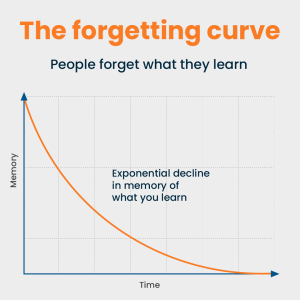How many times have you attended a training course, or completed online learning, only to realise soon after that you’ve forgotten most of the information you learned? You’re not the only one! It’s called the Forgetting Curve and it was developed by Hermann Ebbinghaus back in 1885.
Ebbinghaus’ Forgetting Curve, or simply ‘The Forgetting Curve’ is a mathematical formula that demonstrates the rate at which information is forgotten over time if we make no attempt to retain it.

There are factors that contribute to the rate at which someone forgets what they have learned, including:
- The strength of the memory – the more relevant and meaningful the information is to the person, the more likely it is that they will remember it. People recall stronger messages for longer periods of time.
- The time that has passed since the information was first learned – sometimes this can be just a matter of days from when the information was first learned, unless an effort is made to consciously review it. Cognitive science expert Art Kohn suggests that up to 50% of new information is lost by someone within an hour of learning it and an average of 70% is lost within 24 hours!
- Other contributing factors can include the difficulty of the material and psychological factors including sleep or stress.
But not all is lost! There are methods to help challenge the Forgetting Curve and increase the chances of retaining information learned. These include:
- Regular reinforcement of the training – every time training is reinforced, the rate of decline in remembering reduces. By testing a person’s memory, that memory will become stronger, therefore staging regular training interventions can help to solidify the information they have learned originally. These interventions could be learning bursts (micro learning focussed on key topics from the training) or completing a short quiz. People are able to relearn information more easily than learning the subject matter for the first time.
- Make the training content accessible – people have a better chance of retaining information if the training content is easy to absorb in the first place. Representing information through diagrams, illustrations, or even videos can assist with pushing bite-sized pieces of information that are easier to retain. It’s also important to consider that people have different learning needs and to incorporate these into the training, ensuring it is accessible for all.
- Keep it engaging – when someone is actively engaged in their learning, it keeps them involved and improves their chances of retaining the information learned. There are lots of ways to do this, whether through building in activities in a training session, or including an element of gamification in online training.
- Make it relevant – if the training is relevant, there is more chance they will remember it and make it easier to recall the information learned. People are able to more easily remember information if it ties into real world scenarios.
Can you think of any other methods that can be used to combat the Forgetting Curve?
The primary objective of any training course (whether it’s face to face or online) is to have people walk away with new skills and knowledge. By using what is known about the Forgetting Curve and implementing the techniques we’ve discussed to retain newly-learned information, people can ensure their training experience is impactful and memorable.


